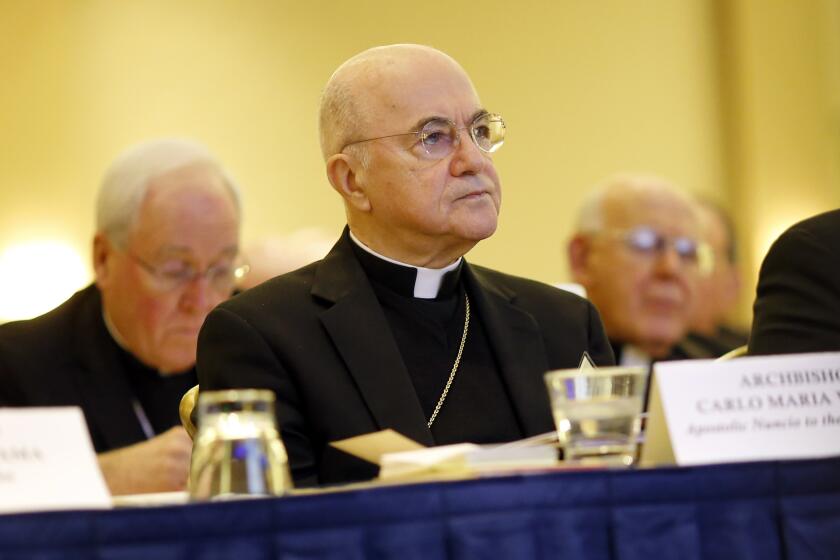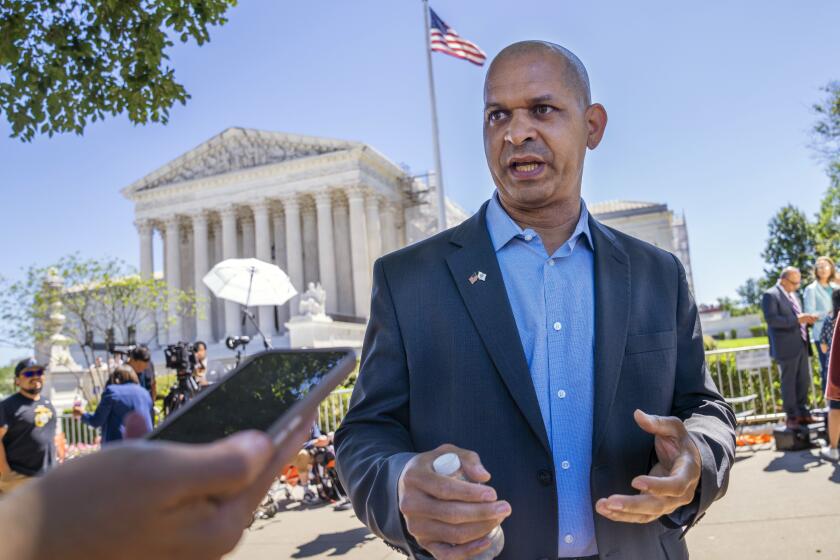Institute Tried to Drum ‘Civilization’ Into Indian Youth
In a small oak-studded spot in Riverside County -- surrounded by a vast sea of homes, a few elderberry trees and native plants -- sits a tiny, near-forgotten cemetery, an island of consecrated tranquillity less than half an acre in size. There, 67 Native American children were buried between 1904 and 1955.
The cemetery is part of the more than century-old heritage of the Sherman Indian High School, about five miles away in Riverside. When it offered 12 years of elementary and secondary schooling to Indian children, it was called the Sherman Institute. The first non-reservation, all-Indian boarding school in Southern California, it is one of four such schools remaining in the nation, all run by the federal Bureau of Indian Affairs.
A 40-year-old memorial in the cemetery bears the names of the students interred there. It stands like a shrine to children sent to Riverside from reservations as far away as New York and North Dakota.
Richard H. Pratt, superintendent of the first federally sanctioned Indian boarding school, which opened in Pennsylvania in 1879, declared: “Transfer the savage-born infant to the surroundings of civilization, and he will grow to possess a civilized language and habit.”
Those buried in the cemetery died far from home, of disease and in accidents. Only five of the headstones are still legible. Lizzie Edwards, 15, and two of her younger siblings were the first to be buried there, victims of typhoid fever in 1904.
Adolph James, a shot-putter, died in 1926 after he was struck in the head by a 12-pound shot. Olin Zhebe-Nolli, 20, fell to his death from a freight train while running away and heading home to the Navajo Reservation in Arizona in 1921.
Some of those who died were orphans. The bodies of others could not be sent back because of their remote homes or religious beliefs.
More than a century ago, it was the federal government’s quest to use education to assimilate Indians into mainstream society and rid the country of so-called Indian problems.
The Sherman Institute began with one man whose interest was not so much in education as in money.
Capitalizing on nostalgia for California’s pre-Yankee heritage and the vogue for Helen Hunt Jackson’s 1897 novel “Ramona,” entrepreneur Frank Miller opened the Mission Inn in 1903.
Three years before, he had pulled enough strings in Sacramento to move the 8-year-old Perris Indian School from that remote town to land he owned in Riverside. He accomplished that in part by arguing that Perris lacked enough water to support the school.
After the move, the institution was renamed for Rep. James Schoolcraft Sherman, whom Miller and his allies persuaded to support a new facility. Sherman went on to become vice president under William Howard Taft.
Tourism played a big role in Miller’s motives. He reasoned that the Indian students would be a cheap source of labor and entertainment for guests at the Mission Inn. And, as he had planned, the school was dedicated the same year that the inn -- a resort for wealthy wintering Easterners -- opened its doors.
Hundreds of young Indians, ages 4 to 20, arrived by train or horse-drawn wagon to attend the institute. Some were forced to come; others came by choice from impoverished reservations. But all came with the consent of their parents.
“In military fashion, they were assigned a company (A, B, C) and a room in one of the several dormitories,” including the ones aptly named Ramona Home, for girls, and Alessandro Lodge, for boys, after the lovers in “Ramona,” said Lorene Sisquoc, teacher of native traditions and basketry and curator of the Sherman Indian Museum.
The school’s objective was to teach order and discipline, to remake the students into the image of the white farmer and to strip away their culture and religious practices.
“One of the goals of the non-reservation boarding schools was, in addition to the assimilation of children and youth, to have them, in turn, influence their families back on the reservation. They would learn the ways of ‘civilization’ at school and, theoretically, impart these ways to their parents, thereby killing two birds with one stone, so to speak,” said archeologist and historian Jean Keller, author of the recently published book “Empty Beds -- Indian Student Health at Sherman Institute, 1902-1922.”
“In many cases, the children had changed so much that they no longer wanted to be on the reservation, because traditional lifeways had become foreign to them,” Keller said.
Among the institute’s teachers was Laura M. Cornelius, an Iroquois who was credited with squelching an attempted Indian uprising on Warner Springs Ranch near the turn of the century. In 1904, Cornelius left to go to Stanford Law School to better help her people.
The school nurse was Mary Israel, who overcame both tradition and bigotry to become the nation’s first Native American female doctor. But even after graduating from Georgetown University and training at Johns Hopkins, she could not get a job as a physician. No one would hire her as a doctor -- not even the institute, which hired her instead as its resident nurse in 1907. She trained girls as nurses to work in hospitals.
Sherman’s notable graduates include Robert Summers Yellowtail, who planned to become a lawyer, but instead became involved in tribal affairs and politics. He was known as a modern-day warrior who fought the tribe’s battles with words. He turned down an offer to head the Bureau of Indian Affairs and instead became patriarch of the Crow Nation before his death in 1988. “I never did get along with the Indian Bureau, even when I worked for it,” he said.
And many a sports enthusiast of the day agreed that Albert Ray, a Pima Indian and Sherman student, was on his way to the 1916 Olympics as the “greatest marathoner of his time.”
In 1913, Ray and his Sherman teammates dominated two prestigious 10-mile road races, sponsored by the Los Angeles Athletic Club and the Los Angeles Times.
But there were no 1916 Olympics Games because of World War I. Ray, who enlisted in the military, died in action in France.
By 1926, more than 1,000 students were enrolled at Sherman, studying such trades as carpentry; painting; blacksmithing; wagon-, shoe- and harness-making; tailoring; agriculture; home economics and nursing.
Students worked on the 100-acre Sherman Farm in what is now Home Gardens off Magnolia and Indiana avenues, raising food for the school and selling the surplus to augment its income. The school’s marching band was so popular that scouting agents, looking for entertainment, wrote to Miller asking to borrow the band.
“I believe the music will prove very acceptable and will be a novelty, and as the boys are not ‘union men,’ you will get all the music out of them that you want,” Miller replied.
History has questioned his motives.
“Miller may have felt he was doing a great service to the Indians by working to create the school; the fact remains that whatever his other motives might have been, he sought profit through exploitation.... [Hindsight] leaves him a bit less lofty and the reader a bit closer to the truth,” wrote Nathan Gonzales in “Riverside, Tourism and the Indians: Frank A. Miller and the Creation of the Sherman Institute,” published in the Southern California Quarterly, Fall/Winter 2002.
By 1938, Sherman had become a fully accredited high school. During the 1960s and ‘70s, when the school’s name was changed to Sherman Indian High School, its emphasis shifted from vocational to academic and college prep studies.
More than 350 students are now enrolled, many of them from as far away as New Jersey, Mississippi and Alaska.
In the lobby of the school auditorium is an exhibit, “100 Years of Education and Native Pride,” masterminded by Keller and Sisquoc, which takes visitors through the school’s evolution. Powerful photographs capture not only defiance and confusion on many young faces, but also moments of sheer joy.
Over the years, the government sold the land surrounding the graveyard, which became choked with weeds and filled with broken headstones.
Recently, a battalion of volunteers, including Eagle Scout candidate Jasen Aebischer, 15, spruced it up with native plants, trees and an irrigation system. The group hopes to raise enough money for new headstones, emblazed with the Sherman Indian medallion.
More to Read
Start your day right
Sign up for Essential California for news, features and recommendations from the L.A. Times and beyond in your inbox six days a week.
You may occasionally receive promotional content from the Los Angeles Times.






